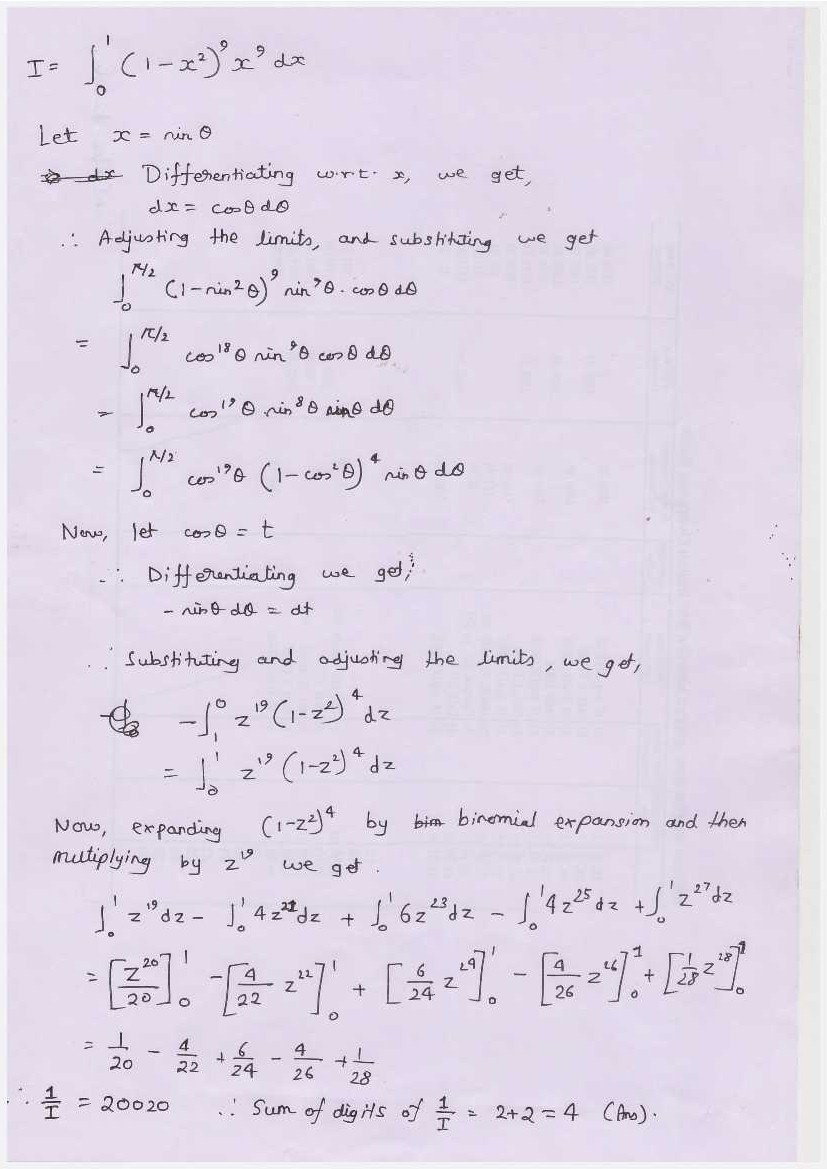Fun with Integration
∫ 0 1 ( 1 − x 2 ) 9 x 9 d x
Let I denote the value of the integral above. What is the sum of digits of I − 1 ?
The answer is 4.
This section requires Javascript.
You are seeing this because something didn't load right. We suggest you, (a) try
refreshing the page, (b) enabling javascript if it is disabled on your browser and,
finally, (c)
loading the
non-javascript version of this page
. We're sorry about the hassle.
5 solutions
i miscalculated twice and the third time when i got the right answer i missed that the answer entered should be sum of digits of the inverse of I . silly me.
Moderator note:
You don't need to use trigonometric substitution. A better substitution to use is y = 1 − x 2 or y = x 2 . Do you see why?
And there's a simpler approach afterwards too. Are you familiar with Beta functions?
∫ 0 1 x m ( 1 − x ) n d x = ( m + n + 1 ) ! m ! n !
I am not familiar with beta function right now. So, I did it by substitution.
Beta Functions?
And both substn and beta fn require calculation
Use Wallis Formula
Trigonometry substitution is lengthy
At least I know how to do this by trig substitution rather than some fancy beta function
You can use the trigonometric representation of the beta function. That makes it really easy.
We have: ∫ 0 1 x n ( 1 − x 2 ) m d x = = 0 ( n + 1 x n + 1 ( 1 − x 2 ) m ) ∣ ∣ ∣ ∣ 0 1 − ∫ 0 1 n + 1 x n + 1 m ( 1 − x 2 ) m − 1 ( − 2 x ) d x = n + 1 2 m ∫ 0 1 x n + 1 ( 1 − x 2 ) m − 1 d x
Therefore:
∫ 0 1 x 9 ( 1 − x 2 ) 9 d x = 1 0 1 8 ⋅ 1 2 1 6 ⋅ 1 4 1 4 ⋅ … ⋅ 2 6 2 ⋅ ∫ 0 1 x 2 7 d x = 5 ⋅ 6 ⋅ … ⋅ 1 3 9 ⋅ 8 ⋅ … ⋅ 1 ⋅ 2 8 1 = 1 0 ⋅ 1 1 ⋅ 1 2 ⋅ 1 3 ⋅ 2 8 4 ⋅ 3 ⋅ 2 ⋅ 1 = 1 0 ⋅ 1 1 ⋅ 1 3 ⋅ 1 4 1 = 2 0 ′ 0 2 0 1
I particularly started using Gamma from today, so ∫ 0 π / 2 cos m x sin n x d x = 2 Γ ( 2 m + n + 2 ) Γ ( 2 m + 1 ) Γ ( 2 n + 1 )
So, substituting x = sin θ d x = cos θ d θ I = ∫ 0 π / 2 cos 1 9 θ sin 9 θ d θ = 2 Γ ( 2 3 0 ) Γ ( 2 2 0 ) Γ ( 2 1 0 ) I = 2 ⋅ 1 4 ! 9 ! ⋅ 4 ! = 2 0 0 2 0 1
Or as an alternative, Beta also helps. Substituting x 2 = t 2 x d x = d t I = ∫ 0 1 ( 1 − t ) 9 t 4 d t = B ( 1 0 , 5 )
And then going back to Gamma, B ( x , y ) = Γ ( x + y ) Γ ( x ) Γ ( y )
So, I = B ( 1 0 , 5 ) = Γ ( 1 5 ) Γ ( 1 0 ) Γ ( 5 ) = 2 ⋅ 1 4 ! 9 ! ⋅ 4 ! = 2 0 0 2 0 1
Note some important properties: Γ ( x ) = ∫ 0 ∞ e − t t x − 1 d t B ( x , y ) = B ( y , x ) = ∫ 0 1 t x − 1 ( 1 − t ) y − 1 d t ∫ 0 π / 2 cos m x sin n x d x = 2 Γ ( 2 m + n + 2 ) Γ ( 2 m + 1 ) Γ ( 2 n + 1 ) B ( x , y ) = Γ ( x + y ) Γ ( x ) Γ ( y ) Γ ( 2 1 ) = π
'beta' makes it a child's play!!!!
We can directly use Wallis Formula by just plugging in x=Sinz

let t = x 2
d t = 2 x d x
∫ 0 1 2 1 ( 1 − t ) 9 t 4 d t
using beta function
∫ 0 1 ( 1 − t ) x − 1 t y − 1 = ( x + y − 1 ) ! ( x − 1 ) ! ( y − 1 ) !
I = 2 1 × 1 4 ! 9 ! × 4 !
I − 1 = 2 0 0 2 0